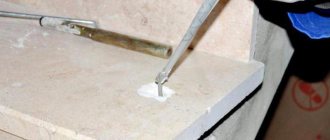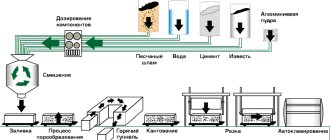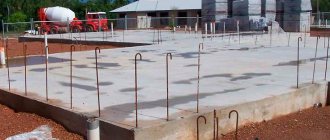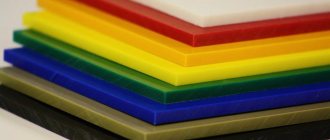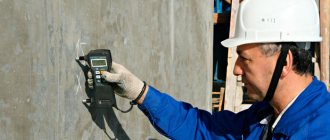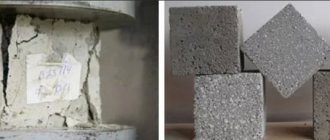Caring for fresh concrete
The main enemies of the correct concrete hardening process, which significantly worsen its quality and structure, are:
- Cooling.
- Rapid loss of moisture.
Harmful problems that arise in the process of curing concrete until it reaches its design strength during the cold season are:
- Freezing of water included in the concrete mixture, which can provoke the destruction of freshly poured concrete.
- Slowing down the cement hydration process.
- Reduced adhesion of concrete to the reinforcing frame due to icing of the latter.
- Cracking of the concrete surface and even the appearance of cracks in the body of the structure.
Rapid loss of water when performing concrete work in the heat can threaten to completely stop the strength gain of the hardening mixture. Which, in fact, will lead to expenses for repair and dismantling work.
But the worse thing is that this loss of strength is not always noticeable and taken into account by construction organizations. This unpleasant fact emerges when the house is standing and the foundation settles unevenly.
Many people lay the material after two or three days so that the cement sets as a crust.
Attention! Research in this area shows that a concrete mixture hardened at high temperatures (up to 40 degrees) under the scorching rays of the sun without quality care, at the age of 28 days gained 54-56% of the design strength. And, what is more dangerous, it is almost impossible to compensate for the loss of strength characteristics during such hardening.
Therefore, in order to maintain the strength properties of concrete at a high level, freshly poured structures require certain care, which does not take much time, but provides a positive result.
The concrete curing process instructions recommend the following maintenance measures:
- Covering with heat-insulating and moisture-retaining materials - and these do not necessarily have to be expensive products.
- Moistening the concrete surface (in the heat, when temperatures are above 20 degrees).
- Warming up using heat guns or electric heating at sub-zero temperatures.
Application of antifreeze additives
Winter is not the best time for construction work. This is especially true for pouring concrete. The main participant in the chemical processes that occur during the hardening of the mixture is water. The hydration of cement slows down with decreasing temperature, and the hardening time increases greatly. When the temperature changes from 20°C to 50°C, the time to gain strength increases by 3-4 times.
If the solution freezes, excess pressure is created by the frozen water. Ice films form around the fillers, worsening the bonds within the mixture. The worst thing is if this happens at an early stage of setting. In this case, even with a further increase in temperature, the concrete will not be able to gain grade strength.
It is allowed to fill in the cold season if this is determined by the schedule of events. Such work is determined by SNiP, which allows pouring concrete in winter. This document defines the onset of winter conditions at a temperature of 5°C and dictates how much to heat the material.
To protect the mortar from freezing, there are proven methods for curing concrete in winter conditions. These include various types of heating, covering the mixture, and adding antifreeze additives. The main task during winter concreting is protection from freezing until critical strength is reached, the value of which corresponds to 50% of the brand value.
We suggest you read: How to make a gable roof under metal tiles
The introduction of chemical additives when pouring concrete in winter allows the mixture to be poured without heating. This method is economically beneficial and does not require the installation of additional heat-saving structures at relatively low temperatures. The use of additives can complement heating of the hardening material. In both cases, there is a noticeable reduction in costs if used in conjunction with the Thermos method.
To pour concrete in winter, two types of additives are used: to accelerate hardening and to lower the freezing point. The recommended concentration is from 2% to 10%, the exact figure is selected depending on the air temperature and the mass of dry cement. Adding chemicals is one of the methods of winter concreting, appropriate in late autumn and at the first frost.
Among the most common additives to concrete are:
- Sodium nitrite NaNO2 (salt of nitrous acid). Improves hardening strength at temperatures not lower than 18.5 °C. Plus - anti-corrosion effect, minus - stains remain on the surface of the concrete.
- Calcium chloride CaCl2. If the appearance of efflorescence on the surface of the hardened material is not critical, this product will speed up the setting of concrete. You can work with it down to -20 °C; the grade of cement powder should increase with the concentration of chloride introduced.
- Potassium carbonate (potash), K2CO3, also known as potassium carbonate. The best modifier for concrete in terms of convenience and properties. It does not leave streaks or corrosion on the fittings. The only drawback is that this catalyst acts too intensely on the solidification rate. You need to complete the job in 45-50 minutes.
You cannot add “chemicals” to pure concrete! First, it is stirred in water, then combined with a cement mixture. For uniform hardening, increase the mixing time by 1.5 times. Ordinary salt can improve the hardening of the concrete mixture, but only slightly.
Covering concrete
The topic of today's article is covering material for concrete:
- In the heat of summer, it protects the mixture from premature drying under the scorching rays of the sun.
- In winter from the destructive effects of low temperatures and frost.
Various types of shelters, available in a wide range on the domestic building materials market, cope well with these problems. Let's look at the main ones.
Fabric and multilayer
- Tent shelters without additional insulation.
The following may serve in this capacity:
- Awnings made of synthetic fabrics.
- Awnings made of synthetic fabrics impregnated with PVC.
- Tarpaulin canopy for covering concrete with impregnation (water-repellent and fire-resistant).
The tarpaulin is highly durable
- Insulated tent shelters.
The following is used as insulation:
- Polyester is a synthetic fabric.
- Synthetic winterizer with frost-resistant (withstands about 70 degrees below zero) and hydrophobic impregnation.
In the photo - a piece of fabric with padding polyester, fixed to the formwork with eyelets
- Multilayer awnings , which are a sandwich laminated with a water-repellent and UV-resistant film on both sides.
The sandwich consists of:
- Two layers of woven polyethylene fabric.
- The insulating layer between them is made of isolon.
Film materials
- Polyethylene films, for example - "Izokom". This material is used to cover concrete immediately after pouring the mixture onto a wet surface.
For your information! Foamed using a special technology that excludes the use of harmful substances, this material is very resistant to aggressive environments. It is environmentally friendly, does not rot, and due to its increased density, it is a highly negotiable material with a service life of tens of years.
- Covering material PPE and PPE NH can be used directly on a concrete surface, without fear of precipitation in the form of rain and snow getting on it. A high degree of water resistance and excellent thermal insulation properties will ensure reliable protection of concrete at any humidity and temperature conditions in the range from -40 to +90 degrees. The material also copes well with temperature changes.
Shelter and heat guns
There are several ways to warm up concrete in winter; heating formwork is one of the simple and easy to install. It consists of two plywood sheets and an infrared film pressed between them. The latter can heat concrete up to 60 cm deep due to the characteristics of the distribution of radiant energy. The advantage of this method is uniform heating; the frozen surface will not have cracks.
After warming up the formwork, you need to turn it off and pour the solution into it. The temperature ranges from 60 to 80 degrees Celsius, held until 80% strength is reached. To reduce heat loss, the free part of the formwork should be covered with a thermal insulation layer.
If access to uninterrupted electricity is not available, diesel heat guns can be used. Build a shelter over the heating area where hot air will be supplied. This method is expensive; an alternative, double-walled formwork, is used more often.
Conclusion
Now you know how to protect concrete in winter or summer from the adverse effects of the environment. Carefully care for a fresh concrete surface, and it will reward your efforts with a long period of safe and efficient operation of the building.
In the video presented in this article you will find additional information on this topic.
In fact, concrete is used at every construction site; its main indicator is strength, which is not always achieved at the required level. In order for the fresh solution to then gain brand strength within the prescribed period (28 days), perfect conditions for hardening are needed. But in life, on large or private construction projects done with one’s own hands, there are no perfect conditions; much more often, concreting is carried out either in the heat or in winter.
Caring for fresh concrete
The main enemies of the correct concrete hardening process, which significantly worsen its quality level and structure, are:
- Cooling.
- Rapid loss of fluid.
Harmful problems that appear during the curing of concrete to its design strength during the cold season are:
- Freezing of water included in the cement mixture, which can cause destruction of freshly poured concrete.
- Slowing down the cement hydration process.
- Reduced adhesion of concrete to the reinforcing frame due to icing of the latter.
- Cracking of the concrete surface and the origin of cracks in the body of the structure.
The rapid loss of water during cement work in the heat can threaten the complete cessation of the strength of the hardening mixture. Which, in fact, will lead to expenses for repair and dismantling work.
But the worse thing is that this loss of strength is not always noticeable and taken into account by construction organizations. This unpleasant fact emerges already at a time when the house is standing and the foundation settles unevenly.
Attention! Studies in this area indicate that the cement mixture, hardened at high temperatures (up to 40 degrees) under the scorching rays of the sun without quality care, at the age of 28 days gained 54-56% of the design strength. And, what’s more scary, it’s virtually impossible to compensate for the loss of strength characteristics during such hardening.
Based on this, in order to maintain the strength properties of concrete at the highest level, freshly poured structures require certain care, which does not take a lot of time, but provides a good result.
The concrete curing process instructions recommend the following maintenance measures:
- Covering with heat-insulating and moisture-retaining materials - and these do not necessarily have to be expensive products.
- Moisturizing the cement surface (in the heat, at a time when temperatures are more than 20 degrees).
- Warming up using heat guns or electric heating at sub-zero temperatures.
What is the optimal temperature for concrete hardening?
The acquisition of materials of the required conditions and its functional properties strongly depend on the state of the environment. At temperatures from 15°C to 25°C, the mass gains 70% strength in 7 days. It takes about 30 days to reach the stone state. During the cold season, the rate of hardening decreases.
A further drop in temperature leads to a complete stop of all processes. How concrete will behave during the subsequent thaw depends on the stage at which freezing occurred. If the mixture freezes after reaching critical strength, then there will be no significant disturbances during thawing.
Conclusion
Now you understand how to cover concrete in winter or summer from the negative effects of the external environment. Take meticulous care of the fresh cement surface, and it will reward your efforts with long-term reliable and efficient operation of the building.
In the video presented in this article you will find additional information on this topic.
Since construction work usually continues all year round, its implementation requires solving a number of important tasks, one of which is concreting. To create a durable surface within the required period (28 days), the solution must be in conditions optimal for hardening. However, in real life, concrete laying is usually carried out in any weather, which makes it difficult to strictly adhere to the required temperature and humidity conditions.
Possible consequences of winter concreting
Failure to comply with concrete laying technologies in winter results in concrete products of reduced strength, with cracks, efflorescence and other defects, as well as poor adhesion to reinforcement. The products are short-lived in use.
Concrete work in winter is most often a necessary measure, but even in this case there are advantages. When choosing a technology for winter work, many factors are taken into account: the type of structures, the composition of the concrete mixture, the availability of equipment and the economic effect of their use. Antifreeze additives are desirable for use when choosing any method of conducting concrete work in winter.
Negative impacts of natural factors
Summer heat and winter frosts negatively affect the quality of concrete work. At high air temperatures, rapid evaporation of water from the mixture occurs, which can lead to the cessation of strength gain by the hardening solution.
There is a high risk when working in winter:
- freezing of water entering the concrete solution;
- deterioration of adhesion to an icy frame;
- formation of cracks on the surface and inside the concrete structure;
- drop in cement hydration rate.
Rain, rain, and snow can cause considerable damage to a fresh concrete surface. Its condition is affected by both high humidity and chemicals contained in precipitation.
Concreting technology in winter conditions
As part of the work project, activities are developed that ensure:
- Preventing concrete mortar from freezing during transportation, laying and compaction.
- Prevention of freezing of freshly laid concrete until critical strength is achieved.
- Favorable heat and humidity conditions for strengthening of hardening concrete.
The finished concrete mixture supplied to the construction site must have a temperature of at least 5°C. To do this, mixing is carried out in warm (up to 70°C) water, and the filling materials are heated.
Surfaces for concreting and reinforcement must be heated close to the temperature of the concrete solution, for which warm or hot air is used, but not steam or water.
When transporting the finished concrete mixture for a long time and it is impossible to use heating, antifreeze additives are used.
There are two main methods of winter concreting:
- warm concrete;
- cold concrete.
Cold concrete is concrete that will harden without heating. To ensure its hardening, special antifreeze additives are designed to reduce the freezing point of water and at the same time accelerate hydration reactions so that the amount of unbound water in the solution decreases as quickly as possible.
Widespread antifreeze additives are electrolytes, Na and K salts, but their use has some limitations:
- sodium salts are not used in reinforced concrete, as they lead to corrosion of the reinforcement;
- some types of Portland cement (for example, highly alkaline or made from clinker with a high content of aluminosilicates) are not used in conjunction with electrolytes;
- sodium and potassium salts are not used in mixtures with potentially reactive rock filler;
- electrolyte salts should be tested experimentally for the formation of efflorescence.
Modern complex antifreeze additives do not have the disadvantages of electrolyte salts, provide the ability to carry out concrete work at low temperatures and have a complex effect (not only antifreeze, but also plasticizing and others).
Warm concrete is concrete that, after laying, is subjected to various heating and heating procedures.
Types of awnings
Three-layer mats provide reliable protection of concrete from low temperatures, ultraviolet rays, precipitation and other moisture. Thanks to this, the hardening process can take place not only in comfortable weather, but also in rain, snow, and frost.
From a large assortment of similar products, we will consider several of the most popular types:
- PVC mats with isoline. Standard insulating mats are designed to work at temperatures down to -40° C. Even greater frosts - up to -50-65° C can be withstood by reinforced and frost-resistant PVC awnings. The product line also includes fireproof products that require layers to be treated with special impregnation;
- Awnings made of OXFORD fabric with padding polyester filling. These awnings are characterized by low weight and high elasticity of the products. Such mats, which can withstand temperatures down to -70° C, can not only cover concrete in winter, but also create a thermal contour and protect complex architectural elements;
- Covering awnings POLYTARP. They are made from woven polyethylene fabric, which has waterproof properties. A layer of foamed polyethylene foam is used as insulation in such products.
Other types of imported and domestic materials can also be used as a base and insulation materials; in addition, when making insulated mats, other combinations of layers are acceptable.
How to heat concrete with a wire
A simple and easily implemented thermos method for winter concreting does not require any special costs. The material heated above SNIP (25-45 degrees) is quickly poured into the formwork and covered with thermal and vapor insulation. As a result of hydration, the mixture does not cool down and gains the required strength. Cement itself generates heat of about 80 kcal.
Before starting work, you need to carry out a thermal engineering calculation - how much to heat the concrete: the amount of heat in the concrete should be equal to the heat loss when cooling to zero. The period of temperature decrease is characterized by positive temperature and a gain in design strength.
The absence of energy costs and additional materials makes this concreting technology economical in winter conditions. Together with it, chemical additives are used to lower the freezing point.
Winter concreting methods are not limited to the simple use of thermal insulation. Electric heating, similar to “warm” floors, is often used. A heating wire is attached to the reinforcement, after which the mixture is poured into the formwork (its temperature is not lower than 50C). Connect the ends of the cable to the current source, do not forget about the step-down transformer. After switching on, heating occurs at a rate of 10 degrees per 10 minutes until reaching 50-60°C. Then the mixture is gradually cooled 2 times slower.
Concrete is heated in winter with special wires - PNSV or PTZH, they are both made of steel, but the latter has two wires (if one is damaged, heating continues). The diameter of the wire is usually 1.2 mm, the quantity per 1 m³ is 50 m. After pouring, the wire remains inside, it can be laid at -15°C, and heated at 25°C.
The advantages of this method are low energy consumption and the ability to heat large volumes. To ensure that the mixture hardens evenly, you cannot change the time intervals between temperature jumps.
The electrode method, when the reinforcement is tied with wire connected to a step-down transformer through wires, is less effective. In this case, the conductor is water; when it dries, the consumption of electricity sharply increases.
Wire laying
It is advisable to use technically complex methods of winter concreting using insulated formwork, heating electrodes, laying a heating cable, etc. These methods require careful preliminary calculations.
To achieve maximum strength, you need to know at what temperature to pour concrete and the optimal methods for ensuring hardening. In addition, proper preparation of the formwork is required. Before pouring the solution, it is necessary to thoroughly clear it of ice. The soil and reinforcement need to be heated, for which braziers, heat guns, infrared emitters and other devices are used.
Working with a strip foundation in such weather is quite possible. To do this, you need to warm up the trench gradually by pouring concrete into it. After pouring, a mandatory step is high-quality thermal insulation. The process continues until the perimeter is closed. With the use of additives in the concrete solution and high-quality insulation, the strip foundation can be poured at temperatures down to -15⁰C.
When laying concrete, regardless of the type of structure, continuity of work is required until the monolith is completely poured. To successfully complete the work, it is necessary to calculate the supply of the required amount of solution and the optimal number of workers.
We suggest you read: How to glue penoplex to a concrete ceiling
Before pouring the solution into the formwork, you need to make sure that its temperature is optimal - around 38⁰C. If it exceeds 40 degrees, the hardening rate will decrease due to a decrease in the quality of cement. As a result, it will take too long to reach critical strength, the liquid in the solution risks freezing, and the concrete will lose its properties.
Answering the question whether pouring concrete in winter is possible, we can say - definitely yes. With the right technological approach, these works can be carried out at the lowest temperatures. Laying without additional heating can be done in mild frosts; this will require good thermal insulation and pre-heating of the concrete solution.
At low temperatures, additional heating of the concrete mass is required. It is carried out using various methods, which must be selected directly at the construction site. The costs of heating and thermal insulation pay off, since substandard concrete will reduce the quality of the entire structure.
Properties of insulated awnings (mats)
Regardless of the materials used, such products have the following qualities:
- light weight (weight of 1 m2 is 0.5-2 kg);
- high base density (up to 950 g/m2);
- excellent heat resistance (mats can be used at temperatures down to – 70° C);
- uniform heat distribution.
The use of mats prevents freezing of concrete, accelerates the hardening process, improves the quality of the coating and prevents the appearance of cracks.
Selection of covering material
When choosing a coating, you should pay attention to a whole range of factors. It is necessary to take into account the temperature range and weather conditions during which the work is planned to be carried out, the size of the site, the allocated budget, the urgency of the task (possibly filling the site with concrete can wait until after the rainy days).
It should be remembered that the mats used to cover concrete can only retain, and not generate heat. During prolonged frosts, it is advisable to use more advanced specialized types of protection, such as thermo- or electromats.
Thermos method
There are some features of concreting in winter conditions using the “thermos” method. In this case, the solution heated during preparation is poured into the insulated formwork. With this option, it is recommended to additionally introduce antifreeze additives into the solution.
The formwork is insulated with mineral wool mats. The solution during pouring using this method should have a temperature of 60... 80°C. There are several methods for curing concrete in winter conditions.
We invite you to familiarize yourself with: Concrete in winter, methods of concreting in winter
In some cases, the solution is heated at the place of its manufacture, and then it is delivered to the work site. In others, the heating of the composition is carried out directly on the construction site using electrodes.
